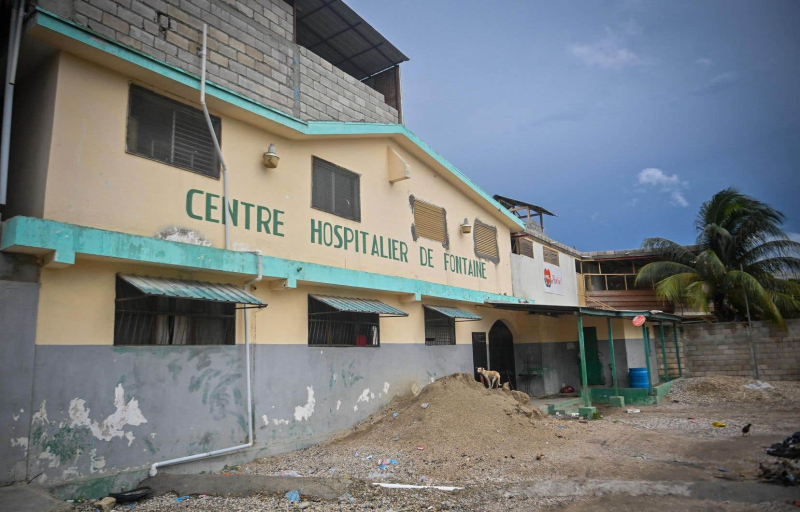
Photo: Richard Pierrin Agence France-Presse The Fontaine hospital center, in the Cité Soleil slum, is one of the hospitals struggling with violence. He had to be evacuated in November following clashes between gangs.
Danica Coto – Associated Press in Port-au-Prince
Published at 11:21 a.m. Updated at 6:51 p.m.
- Americas
On a recent morning at a hospital deep in the Haitian capital's gang territory, a woman went into convulsions before her body went limp, while a doctor and two nurses stood by. rushed to save her.
They placed electrodes on her chest and turned on an oxygen machine while keeping her eyes glued to a computer screen who had a dangerously low oxygen level of 84%.
No one knew what she had.
Even more worrying, the Médecins Sans Frontières hospital located in the Cité Soleil slum was running out of essential drugs to treat seizures. “The medications she really needs are barely available,” lamented Dr. Rachel Lavigne, a doctor with the medical aid organization.
C' is a scene repeated daily in Port-au-Prince's hospitals and clinics, where life-saving medicines and equipment are dwindling, if not non-existent, as brutal gangs tighten their grip on the capital and beyond. -of the. They blocked roads, forced the closure of the main international airport in early March and paralyzed operations at the country's largest seaport, where containers full of essential supplies remain stuck.
“Everything is falling apart,” denounced Dr. Lavigne.
Haiti's health system has long been fragile, but is now on the brink of total collapse after gangs launched coordinated attacks on February 29, targeting critical infrastructure in the capital and beyond.
Violence has forced several medical facilities and dialysis centers to close, including Haiti's largest public hospital. Located in central Port-au-Prince, the Haiti State University hospital was scheduled to reopen on April 1 after being closed at the start of the attack, but gangs infiltrated it.
The University of Peace Hospital, located south of the closed airport, is one of the few establishments still in operation. From February 29 to April 15, the hospital treated some 200 patients with gunshot wounds, and its beds remain occupied.
“We are in dire need of fuel as we run on generators. Otherwise, we risk closing our doors,” warned hospital director Dr. Paul Junior Fontilus in a statement.
Also read
- The composition of the transition council in Haiti finally revealed
- Humanitarians tell of Port-au-Prince’s “open-air prison”
- In a Haiti in crisis, residents of Port-au-Prince recount their “nightmare”
More than 2,500 people were killed or injured in Haiti between January and March, an increase of more than 50 percent compared to the same period last year, according to a recent United Nations report.
Even if a hospital is open, there are sometimes few or no medical staff, as gang violence erupts daily in Port-au-Prince, forcing doctors and nurses to stay home or flee. turn if they encounter roads blocked by heavily armed men.
The spiral of chaos has left increasing numbers of cancer patients, AIDS patients and others serious illnesses without any recourse. The gangs also loot and burn pharmacies in the capital's downtown area.
Médecins sans frontières no longer has medicines to treat diabetes and hypertension, and Asthma inhalers, which help prevent life-threatening attacks, are nowhere to be found in the capital, Dr. Lavigne said.
At the Médecins Sans Frontières hospital, medical staff recently tried to save a boy suffering from a severe asthma attack by giving him oxygen. It didn't work, nor did any other type of medication. Eventually, they ended up injecting him with adrenaline, used in emergency situations to treat anaphylactic shock.
“We improvise and do our best for the people here,” explained Dr. Lavigne.
According to Jacob Burns, project coordinator at Médecins sans frontières, the state of health of the residents is worsens because the daily medications needed to treat their chronic illnesses are not available.
“The illness becomes acute and they no longer have other options, a he declared. For some people, there are very, very few options right now. »
Despite the pressing need for medical care, the Médecins Sans Frontières hospital in Cité Soleil has been forced to reduce the number of outpatients treated daily from 150 to 50, according to Jacob Burns, although all emergencies are covered.
Every day, dozens of people line up outside the hospital and risk being shot by gang members who control the area, while they wait medical care.
Everyone is allowed to enter the hospital grounds, but medical staff are setting up a triage system to determine the 50 people who will be supported. Those with less urgent needs are asked to return another day, Burns said.
On average, the Cité Soleil hospital receives three injured people per day, but sometimes up to 14, depending on the staff.
Recently, five people with gunshot wounds arrived to the hospital after spending the night inside a public bus that couldn't move because of heavy gunfire, Burns said.
“Cité Soleil has long been the epicenter of violence. Today, violence is so widespread that it has become a problem for everyone,” he lamented.

